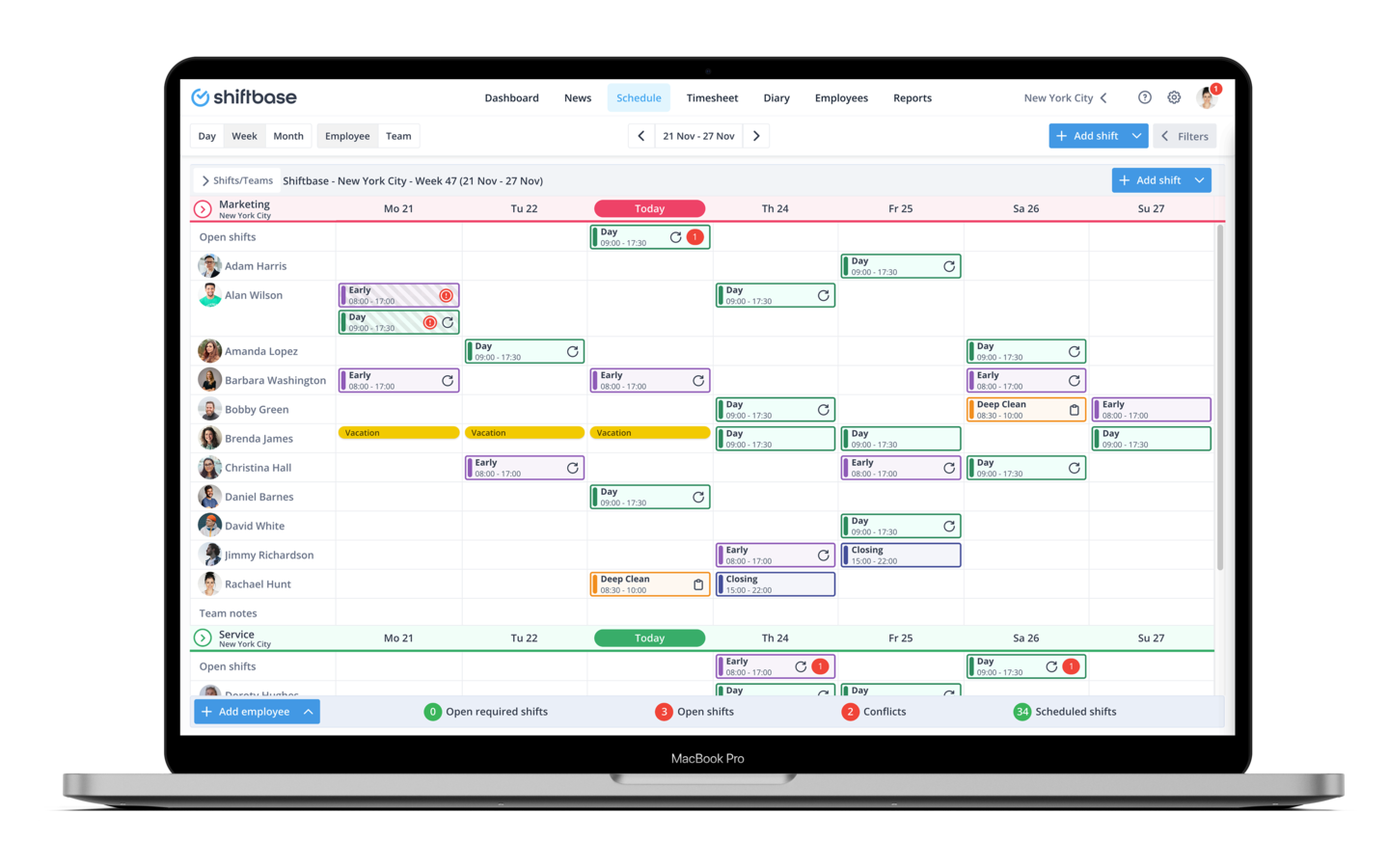
About this template
Excel is used by many companies to keep track of the hours worked by their employees. A time attendance sheet can be customized easily to the needs of any user. To simplify time tracking even further and to bridge the gap until you can switch to Shiftbase, we offer you this free time tracking template.
A timesheet template in Excel is an efficient way to keep track of hours worked by employees or contractors. It is an essential tool for payroll, invoicing, and project management. Not only does it simplify record-keeping, but it also helps to ensure accuracy and transparency.
Why Use Excel for Timesheets?
In a world full of diverse tools and software options, why should one opt for Excel when it comes to creating timesheets? Below are several compelling reasons that demonstrate the unmatched advantages of using Excel for this purpose.
- Accessibility: Excel is a part of the Microsoft Office Suite, which is available to millions of users worldwide...
- Familiarity: Given its longstanding history, Excel is a tool that many people have encountered...
- Flexibility and Customization: Excel is a remarkably flexible tool...
- Powerful Calculations and Formulas: One of Excel’s defining features is its capability to perform complex calculations...
- Data Analysis and Reporting: Beyond basic timesheet functions, Excel offers robust data analysis tools...
- Integration Capabilities: Excel doesn’t exist in a vacuum; it is designed to work seamlessly with other Microsoft products... payroll system, project management software, or other tools your team uses regularly.
- Security Features: Excel comes with a variety of security options...
- Cost-Effectiveness: While there are specialized timesheet software options...
Components of an Effective Timesheet Template
An effective timesheet template is more than just columns and rows. It should be:
- Intuitive and easy to use
- Detailed with categories like date, start time, end time, breaks, and total hours worked
- Customizable to fit the specific needs of your business or project.
Designing Your Excel Timesheet

Starting with Basics
- Columns and Rows to Include: Standard columns may include Date, Start Time, End Time, Breaks, and Total Hours...
- Input Fields and Categories: Besides hours worked, you might need fields for job codes, projects, or departments.
Formatting Your Timesheet
Making a timesheet should not feel like rocket science.
- Making it Visually Appealing: Use font styles, cell shading, and border options to make the timesheet easy to read.
- Data Validation and Restrictions: Set rules to prevent incorrect entries, such as negative time values.
Enhancing Your Timesheet with Excel Features
Excel is more than a digital piece of grid paper. It’s a powerful tool capable of complex calculations and visualizations.
- Utilizing Formulas for Automation: For instance, =SUM(E2:E8) can calculate the total hours worked in a week.
- Creating Data Visualizations: Charts and graphs can make trends and patterns instantly visible.
Securing and Sharing Your Excel Timesheet
Your timesheet template might contain sensitive information. Protect it.
- Password Protection: Secure your document with a password, ensuring only authorized individuals have access.
- Sharing and Collaboration Features: Excel allows for cloud storage and sharing through OneDrive or SharePoint.
Troubleshooting Common Issues
- Handling Errors and Inconsistencies: Conditional formatting can highlight errors in your timesheet...
- Optimizing for Different Versions of Excel: Not all features are available in every version of Excel...
Limitations of Excel Timesheets
While Excel is a powerful and versatile tool, it is not without drawbacks:
- Manual Entry and Human Errors: Reliance on manual entry can lead to inaccuracies...
- Lack of Real-Time Tracking: Excel cannot track hours in real time...
- Limited Access and Collaboration: Multiple people working on the same file can cause version issues...
- Lack of Integration with Other Systems: Excel may not integrate seamlessly with HR or payroll systems...
- Scalability Issues: Larger organizations may find Excel inefficient for managing timesheets...
- No Automated Backup or Recovery: Local Excel files risk corruption or accidental deletion...
- Lack of Mobile Accessibility: Mobile Excel apps may be limited compared to desktop...
- Customization Requires Skill and Time: Tailoring complex Excel timesheets requires expertise.

A Modern Solution to Excel Timesheet Limitations: Shiftbase
While Excel can be a reliable tool for creating timesheets, it has its own set of limitations. Enter Shiftbase, a comprehensive SaaS for workforce management. With Shiftbase, you can effortlessly manage employee scheduling, time tracking, and absence management, all in one user-friendly platform. Shiftbase offers customizable and automated solutions tailored to business needs.
Ready to Make the Switch?
Shiftbase invites you to try our software free for 14 days. This is a no-risk opportunity with no obligation to continue. Sign up for your free 14-day trial of Shiftbase now.



